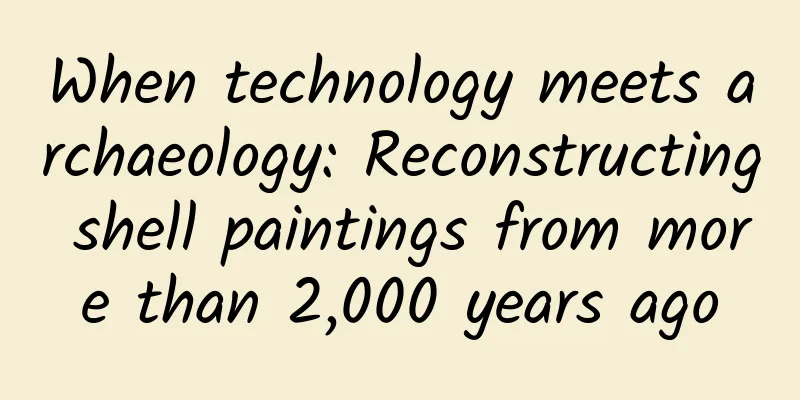When technology meets archaeology: Reconstructing shell paintings from more than 2,000 years ago

|
Produced by: Science Popularization China Author: Chen Dian (University of Chinese Academy of Sciences) Producer: China Science Expo Editor's note: In order to unveil the mystery of scientific work, the China Science Popularization Frontier Science Project launched a series of articles called "Me and My Research", inviting scientists to write articles themselves, share their scientific research experiences, and create a scientific world. Let us follow the explorers at the forefront of science and technology and embark on a journey full of passion, challenges, and surprises. Imagine that you are strolling leisurely on the golden beach. Suddenly, a brilliant light jumps into your eyes. It turns out to be a shell shining in the sun. Shells have special shapes, colorful colors, charming luster and delicate textures, just like miniature works of art carefully carved by nature. In fact, our ancestors discovered the unique beauty of shells hundreds of thousands of years ago. In addition to being food, decoration, production tool, and trading currency, our ancestors also gave shells a deeper meaning, using them as a medium for painting, carrying people's ideas and beliefs. So, what techniques did the ancients use to paint exquisite patterns on tiny shells that have been passed down for thousands of years? What deeper meanings do shell paintings contain? A few shell paintings When you gently play with the shell, you will find that its inner wall is smooth and delicate, which is very suitable as a canvas. Shell painting as an art form has actually existed for a long time. Looking back in history, we can find that the practice of painting on the inner wall of shells once appeared in the Japanese game "Kaihe". "Shell-matching" was popular in the Edo period. The patterns painted on the inner wall of the shell are based on scenes from classical Japanese literature. This game not only requires players to rely on memory to match the corresponding patterns, but also allows players to feel the unique and exquisite artistic charm in each flip and comparison, and experience a double feast of vision and culture. In addition, at the Kimalco site in Collier County, USA, archaeologists have discovered a monochrome shell painting of a human figure drawn between 700 and 1500 AD. Throughout history, there are also many shell paintings in my country. The Cleveland Museum in the United States has two shell paintings from China in its collection, which have long been regarded as early examples of shell painting art. However, due to the lack of detailed archaeological background information, the specific discovery sites, exact creation times, and even the authenticity of these two works are shrouded in mystery. Shell painting from the Cleveland Museum (Photo credit: Photo taken by the author at the Cleveland Museum, USA) However, during the excavation of M32 in the southern cemetery of Xujia Village in Linzi, Shandong Province, archaeologists discovered three groups of shell paintings, which greatly helped my country to study the art of shell painting. These shell paintings vividly show the clothing style, etiquette and customs, and life scenes of the Warring States Period in a unique style. The patterns on the paintings also show that they may have appeared earlier than the shell painting in the Cleveland Museum of Art. Shell paintings unearthed in Linzi (Photo source: Shandong Provincial Institute of Cultural Relics and Archaeology: "Linzi Xujiacun South Cemetery M32 Excavation Report, Haidai Archaeology, Issue 1, 2023) In fact, the shell paintings in Linzi, Shandong are not the only archaeological discoveries. In Lingshou, Hebei, archaeologists have also discovered shell paintings of the same period. These works have obvious similarities with the discoveries in Shandong in terms of painting style and production techniques. Although these discoveries are encouraging, in-depth research on the pigment composition, production process and image details of shell paintings still faces many unknowns. In particular, the Chinese shell paintings unearthed in Qinglian Village, Lingshou County, Hebei Province, have been buried underground for a long time, and the pictures have been eroded and damaged severely. Exquisite craftsmanship Despite this, the researchers still rose to the challenge and used a series of sophisticated detection techniques to successfully reproduce the original appearance of these shell paintings. In the process, the superb craftsmanship of shell paintings also became known to the world. Like other paintings, shell paintings must first determine and outline the general image when they are conceived. Using a three-dimensional video microscope, researchers observed that the ancients used a bas-relief technique called "reduced ground", which means that the maker needs to carefully scrape or smooth the background along the contour of the image, so that the lines of the image gradually stand out, presenting a three-dimensional and layered visual effect. Although this technique is not uncommon, it is undoubtedly a double test of the maker's skills and patience to perform it on small and fragile shells. Details of the "reduced ground" technique of shell painting (Image source: Chen D, Zhang WJ, Zhang WR, Wang XK, Wang WM, Luo WG. A miniature world: Revealing Warring States period shell paintings from Zhongshan State by multiple-methods. Journal of Cultural Heritage, 76, 461-469, 2024) In particular, since the shell itself is a natural curved surface, the effect it presents is different from that of a flat painting. In addition, in shell paintings, due to the need for depiction (such as the fruits on the trees and the patterns of some people's clothes), some areas will also present concave textures. The changes in light brought about by these concave areas, coupled with the superposition effect of layers of paint, make the paintings present rich details at different angles, giving people a sense of "newness every time you look at them." Damaged footage is brought to light So, what kind of paint is used to create the vivid images on shell paintings? In order to reveal the composition of the pigments in shell paintings, the researchers chose to use X-ray fluorescence and Raman spectroscopy to test the shell paintings unearthed from the Zhongshan Kingdom site in Lingshou, Hebei. The results show that the red color of the shell painting is cinnabar, which brings bright and rich colors to the picture; the green color is malachite (copper green), which gives the picture a fresh and natural tone; as for the black, charcoal black is used, which presents a deep and mysterious color. These colors are cleverly changed and matched to form rich layers of light and dark, which complement each other and form a well-defined painting. In addition, traces of red pigment were found on the outside of the shells covered by mud, indicating that there were some drawings here. To ensure that no details were missed, the researchers used multispectral imaging technology to examine the area. Using the minimum noise separation transform and pixel purity index algorithm, the researchers summarized the different colors appearing in this area into six characteristic curves. The results show that in addition to the curves corresponding to the four colors of red, green, black and white, there are two unique curves in the shell paintings, which are closely related to the characteristics of the two soil attachments, brown and dark brown. Although no hidden information was found, the data collected this time provided valuable support for subsequent image restoration work. In addition to analyzing the colors of shell paintings, researchers also believe that these pigments may contain a special adhesive to better adhere to the shells. However, due to the special material of the shells, there are certain risks in the sampling process. At the same time, the curvature of the shells also makes it difficult for portable instruments (such as infrared spectrometers) to perform in-situ analysis. Therefore, it is still not possible to deeply understand the adhesive components in the pigments. The surface of unearthed shell paintings is often covered with mud, making it difficult to reconstruct the image, and hastily cleaning it would risk damaging the surface. Therefore, we need a non-invasive way to look deep inside the sample, and industrial computed tomography (CT) technology plays a key role. When an X-ray beam penetrates a sample, various physical phenomena such as the photoelectric effect, scattering, and electron pair effect will work together to cause the rays to attenuate. Therefore, we can use relevant theories to accurately calculate the three-dimensional distribution information of the linear attenuation coefficient, thereby understanding the distribution and composition of the pigments on the shell painting, and then restore the picture on the shell painting. (a) CT image after processing. (b) Line drawing. (c) The effect after filling the color block. (d) The final image effect based on partial imagination. (Image source: Chen D, Zhang WJ, Zhang WR, Wang XK, Wang WM, Luo WG. A miniature world: Revealing Warring States period shell paintings from Zhongshan State by multiple-methods. Journal of Cultural Heritage, 76, 461-469, 2024) More unsolved mysteries Although we have a certain understanding of the painting techniques of shell paintings, we still need further interpretation of the meaning represented by the images that appear in the picture. For example, what fruit trees appear in the picture? What kind of clothes are people wearing? What kind of headdresses are they wearing? What objects are they handing over? Is this shell painting a series of pictures like a comic strip? There are still a series of puzzles waiting to be solved for shell paintings, which also leads us to explore the rich connotations contained in the pictures of shell paintings. As a burial object, shell paintings may carry deeper meanings. For example, the three groups of shell paintings unearthed in Zibo, Shandong were carefully placed on the north side of the lacquer box outside the coffin, while the shell paintings in Lingshou, Hebei were simply placed between the feet of the tomb owner. These two different placements may reflect different funeral concepts, as well as the differences in the identities, status, and quantity and quality of the burial objects of the two tomb owners. In M32 in Xujia Village, Zibo, a large number of precious bronze, gold, and jade objects were unearthed. These luxurious burial objects show the extraordinary identity and status of the tomb owner. In contrast, the tomb owner of M17 in Qinglian Village, Lingshou County was a woman in her thirties with very few burial objects. As for why the ancients used shell paintings as burial objects, the reason may be that the unique shape of the shell symbolizes fertility, so the ancients believed that the shell could preserve the soul and prevent the body from decaying. In addition, according to the Five Elements Theory and certain myths and legends, the shell may also have the function of guiding the soul of the tomb owner through the Styx to the realm of eternal life. But these explanations are still just conjectures. In addition, shell painting, as an art form, must fully demonstrate the social outlook and cultural connotations of the time. If the two shell paintings in the Cleveland Museum's collection are included in the comparison, obvious similarities can be observed. First, all shell paintings use the "reduced ground" technique, showing the uniformity of craftsmanship; second, the shells used for painting are of the same type and similar size, which shows that the shell materials are carefully selected, which means that the production of shell paintings may follow a standardized procedural framework to ensure the standardization of the works. In terms of subject matter, shell paintings mainly depict scenes of people participating in various activities, which are often closely related to aristocratic status or ritual significance. As for the use of pigments, these paintings use red pigments on the faces and skin of the characters, which may reflect the aesthetic concepts and cultural traditions of the society at that time. Multiple views of two shell paintings (Image source: Chen D, Zhang WJ, Zhang WR, Wang XK, Wang WM, Luo WG. A miniature world: Revealing Warring States period shell paintings from Zhongshan State by multiple-methods. Journal of Cultural Heritage, 76, 461-469, 2024) Conclusion Overall, this unique art form was popular in northern China during the Warring States Period, and its influence continued into the Han Dynasty. As a treasure of ancient civilization, shell paintings not only have special materials, but also diverse themes and ingenious composition, and have high historical, scientific and artistic value. As a model of early Chinese painting art, they witness the brilliance of human wisdom and art. In the future, with the advancement of science and technology, we have reason to believe that more civilizations buried by time will be awakened, allowing cultural relics to truly "speak" and share thousands of years of stories with us. |
<<: Can the human body be directly exposed to space?
>>: Why can’t rainstorm forecasts be 100% accurate?
Recommend
Xie Yan - 100 Ancient Poems in the Textbook
Xie Yan - 100 Ancient Poems in the Textbooks Intro...
Why is Momo still thriving even after KuaiBo died?
Quick broadcast secrets and everyone have had prob...
Event Operations Resume Template
What are the general requirements for event opera...
Nature News: How to break the lies of big models?
The World Health Organization's (WHO) artific...
Humans celebrate the Spring Festival, but these behaviors will make kittens upset? Three tips to reduce the harm
Review expert: Wang Lei, National Park and Nature...
Beware! Blood in stool may not be hemorrhoids, it may also be a sign of cancer! Be sure to do these tests!
As the saying goes, "Nine out of ten people ...
Geological disaster prevention and control
The flood season has arrived. Geological disaster...
What mobile developers need to know about pixels
[[124454]] Pixels are very familiar to web develo...
Interview with Zenny Chen: iOS developers should pay attention to Metal
[[120974]] CocoaChina: How did you get involved i...
People in this group should be careful when getting the new coronavirus vaccine!
Spring is the peak season for pollen allergies Ca...
iOS 13 will also add a dark mode. Is the era of "everyone in black" coming?
I don’t know when it started, but various systems...
Sharing of promotional cases of information flow advertising on Qutoutiao - Zhang Liang Malatang!
Nowadays, most people love spicy food, so everyon...
“Chart manipulation” has enabled Yin Yue Tai to develop a fan business, but can it support a Chinese version of Billboard?
How crazy are Lu Han’s fans? Douban user Vivian d...
Kuaishou short video operation strategy in 2022
1. Current Development Status of Kuaishou As for ...









